How to Set Realistic Deadlines Your Team Can Actually Meet
 Let’s be honest with ourselves here. Meeting deadlines can be stress-inducing and feel absolutely impossible. And when they’re not set realistically, they can result in shipping subpar work.
So, what’s our go-to solution? We push back deadlines.
It's something that's easy to do when we're under crunch time. However, it isn't a solution. Push your deadlines back enough times, and eventually, you won't have a content marketing strategy left to execute.
Content must be created, and it must be delivered on time. Your audience craves it, your boss demands it, and your job literally depends on it.
With the right processes and work habits in place, you'll hit every deadline, every time. Best of all, this isn't as hard to pull off as you might think.
Here’s how to conquer your fear of deadlines and be more productive than ever.
Let’s be honest with ourselves here. Meeting deadlines can be stress-inducing and feel absolutely impossible. And when they’re not set realistically, they can result in shipping subpar work.
So, what’s our go-to solution? We push back deadlines.
It's something that's easy to do when we're under crunch time. However, it isn't a solution. Push your deadlines back enough times, and eventually, you won't have a content marketing strategy left to execute.
Content must be created, and it must be delivered on time. Your audience craves it, your boss demands it, and your job literally depends on it.
With the right processes and work habits in place, you'll hit every deadline, every time. Best of all, this isn't as hard to pull off as you might think.
Here’s how to conquer your fear of deadlines and be more productive than ever.
How to set realistic deadlines your team can actually meet.
Click To TweetManage Deadlines in One Place With These Calendar Templates
Since it’s important to have a place to jot down your deadlines, we’ve bundled together a few calendar templates that are perfect for just that. In this downloadable bundle, you’ll find a:- 2021 Content Calendar Template
- 2021 Social Media Calendar Template
- 2021 Email Marketing Calendar Template
Establish Goals and Guidelines for Your Projects
Before you start any project, you need to establish goals for your team, so they have some guiding principles that will inform their work. What do you hope to accomplish with this project? Some examples of good project goals are:- Increase organic traffic to websites as part of a comprehensive content marketing campaign.
- Build your organization’s reputation as a trusted source of information in your industry.
- Connect with potential customers.
- Create original material to publish to social media outlets.
 In addition to establishing some broad goals — such as getting more web traffic — you should also have some specific guidelines for your team. Some examples of these might include:
In addition to establishing some broad goals — such as getting more web traffic — you should also have some specific guidelines for your team. Some examples of these might include:
- Generate demand for your product or service
- Collect leads or email subscribers
- Raise awareness about a cause
- Build trust with your audience
- Connect with customers consistently
- Inform your community about pressing issues
- Or any other goal important to your organization
Aim To Ship, Not For Perfection
Seth Godin has a lot of awesome things to say about this — shooting for completing projects quickly instead of shooting for perfection.- Write down your deadline. You'll publish on this date whether it's perfect or not.
- Gather everyone's ideas on your project.
- Share those ideas in a way everyone can see, and ask them to take a look. After they look or even miss their due date of looking, that's it. No more updates.
- Draft a blueprint of the project from those rough ideas.
- Get final approval for your project blueprint from the big wigs in your company.
- Ask the folks with sign-off authority a simple question: "If I deliver what you approved, on budget and on time, will you ship it?"
- Don't move forward until you get your yes. Seth says, "Once you get your yes, go away and build your project, thrash-free. Ship on time, because that's what a linchpin does."
Create a List of What Needs to Get Done and When
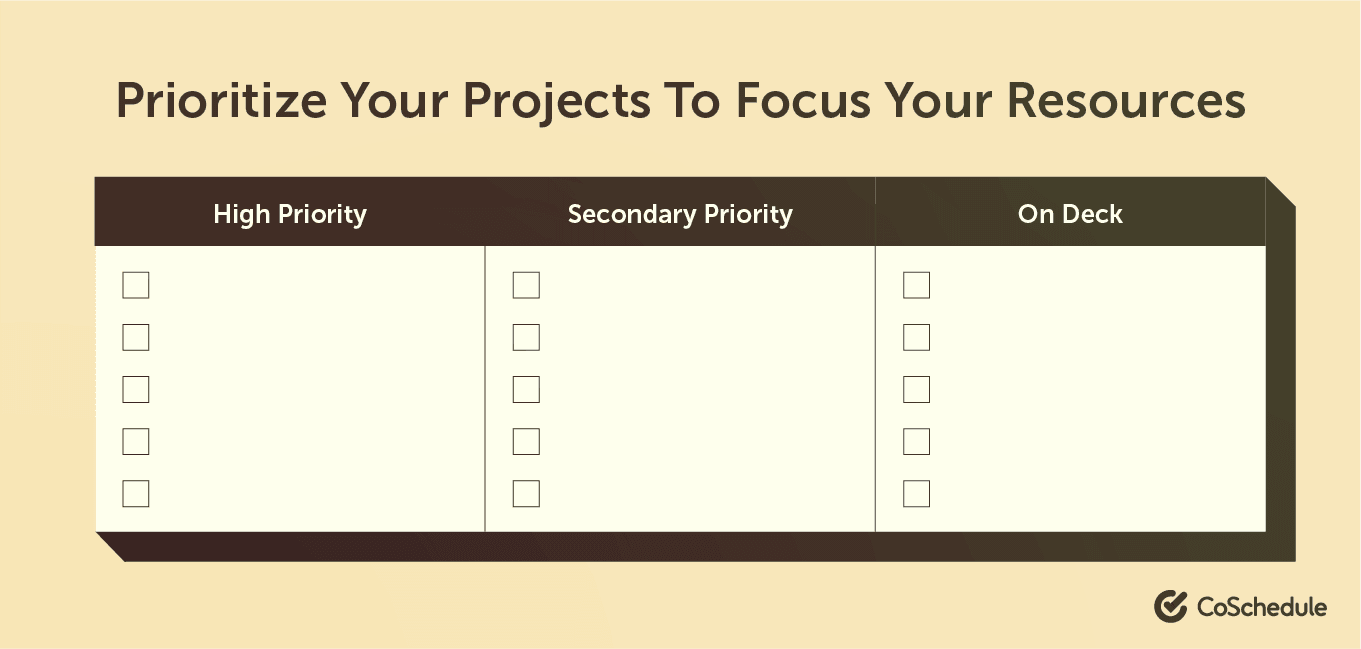 Setting and maintaining timelines and project goals is arguably one of the most challenging parts of being a project manager. Whether you're a one-person operation or have a large team, keeping all these tasks on track and moving forward takes some attention to detail.
CoSchedule makes managing this process easy by providing customizable task templates that you can add to every project, so you can set deadlines, communicate with your team, and keep track of project progress all in one place!
Setting and maintaining timelines and project goals is arguably one of the most challenging parts of being a project manager. Whether you're a one-person operation or have a large team, keeping all these tasks on track and moving forward takes some attention to detail.
CoSchedule makes managing this process easy by providing customizable task templates that you can add to every project, so you can set deadlines, communicate with your team, and keep track of project progress all in one place!
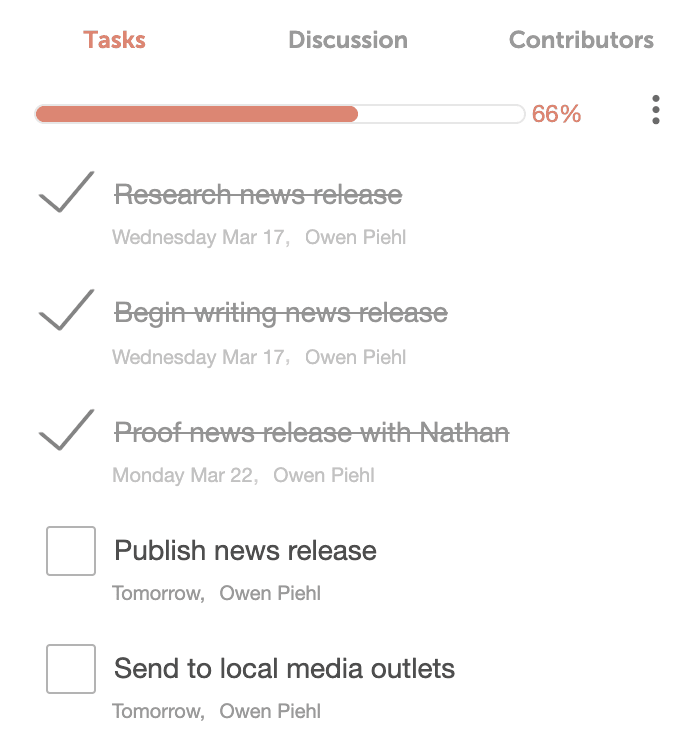 At CoSchedule, we realized that we were running into this problem of maintaining timelines and project goals, so we make sure to discuss the beginning of projects with a creative brief and a kickoff meeting. Then, every morning, the team holds a morning scrum to discuss:
At CoSchedule, we realized that we were running into this problem of maintaining timelines and project goals, so we make sure to discuss the beginning of projects with a creative brief and a kickoff meeting. Then, every morning, the team holds a morning scrum to discuss:
- What you did yesterday
- What you are going to do today
- What’s holding you back from getting things done
Plan how you'll work together as a team to keep each other accountable for meeting your deadlines.
Click To TweetMake Sure Everyone Knows Their Role
Effective business projects often require several people to work together in a collaborative environment. Usually, it’s most effective for roles to be split between two or three people, though sometimes one (very busy!) person may fulfill all roles. For example, when a team is pulling together a blog post, there are a handful of different people with different skills that need to be included.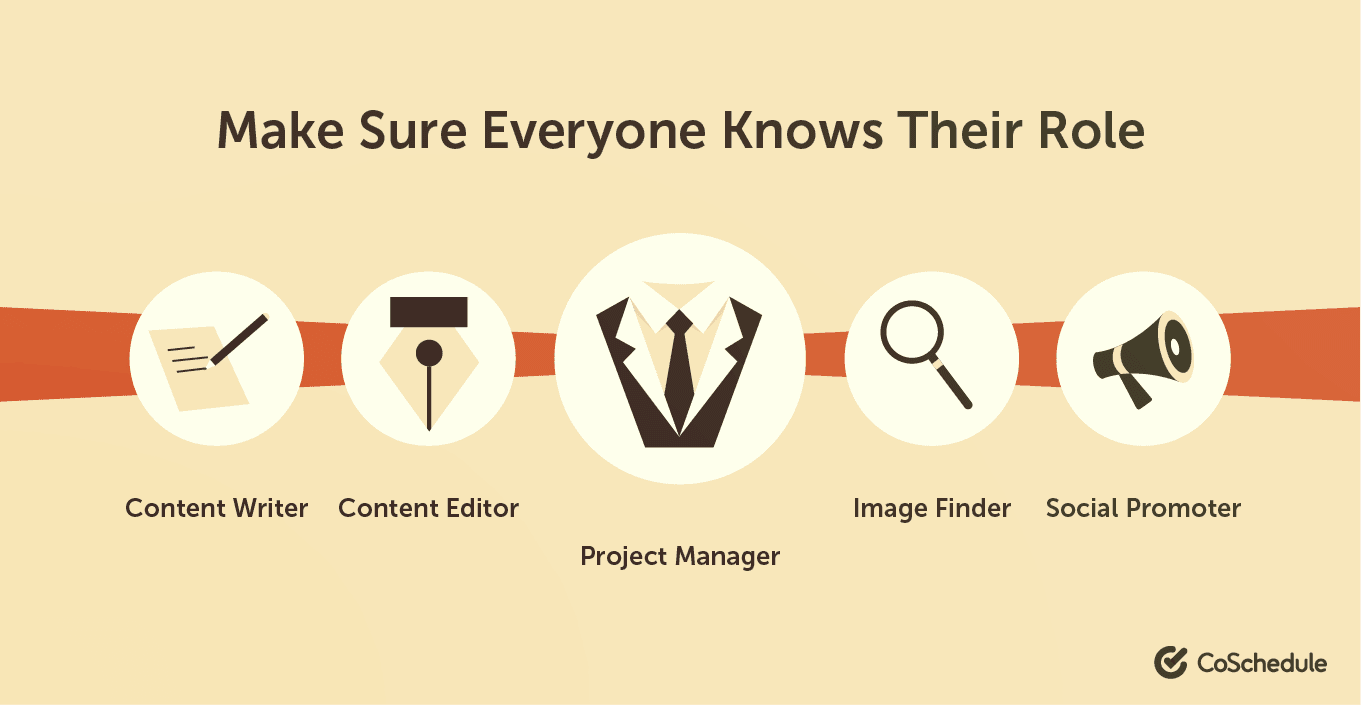 Here are some of typical roles that go into blog post creation:
Here are some of typical roles that go into blog post creation:
- Project manager: This person assigns all tasks and sets deadlines.
- Topic and keyword generator: This person is responsible for finding blog topics and doing research to determine the best keywords and title to use. This person may also be the project manager.
- Content writer: This person is responsible for writing the content, which should incorporate the ideas, keywords, title, etc., as given to them by the project manager or topic/keyword generator.
- Content editor: This person checks and fixes the content’s grammar before the post is published.
- Image-finder and blog publisher: The accompanying images and image tags are essential for a good blog post. Someone must be responsible for finding these images and securing the necessary copyrights. This same person is often also in charge of actually posting the blog — typically using a content management system, like WordPress — and making sure everything looks as it should.
- Promoter: A blog post is not worth much if no one ever reads it. Someone needs to promote your blog on social media — posting links to it across different sites and social media platforms.
It’s good to have team members that can fulfill multiple roles if needed.
Click To TweetDon’t Be Afraid To Delegate Tasks
The wonderful part about being on a team is that you have help. Sometimes, as marketers, we've been conditioned to take on projects without much help because counting on people means leaving your success up to others. It’s great that we have the passion to do a lot, but it can be our downfall. When you delegate tasks, it gives you more time to focus on other projects. It also gets new eyes on the other projects and helps you work quicker. The Muse came up with a great list to help with delegating tasks:- Decide what to delegate: Once you decide to ask for help, pick the projects you need help with. You want to focus on your own strengths and weaknesses to choose what tasks would be better delegated.
- Pick the right people: Just like you chose which tasks aren't right for your skill set, pick your team members who'll be rock stars at those tasks. If you need something edited, think about who the grammar wiz is on your team. Need something figured out with math? Find someone who is better with numbers, and so on. It can be hard to trust new people with a job, but ultimately, you have to do what is best for the project and the timeline.
- Communicate clearly: When you delegate tasks, sit down with your team and clearly spell out what you would like from each person. Getting everyone together may seem like a hassle; however, in the long run, it will save you time and headaches.
- Check in, but don’t be overbearing: You handed off your tasks. Now, you have to trust that your team are professionals and that they will take care of their tasks. It’s easy to want to check every three minutes to make sure everything is getting done, but you need to trust your team — check in sparingly, and then let them continue with their work as well.
- Give credit where credit is due: The project is done, your team worked hard and now you are ready to ship it. Make sure to acknowledge their hard work; they jumped in to help you out — don't take that for granted.
Set Reasonable Deadlines Your Team Can Work With
Everything you've done so far — setting goals, guidelines, and roles — has led up to how to set deadlines that are realistic and achievable for your team. Once everyone knows their role, you need to set deadlines to make sure each team member actually completes their assigned task, and that they do so in a timely manner. In today’s mostly virtual workplace, the best way to set deadlines and make sure everyone is on task is by using a project management tool, like CoSchedule. With CoSchedule, you can manage all communications in one place and ensure all tasks and subtasks are completed on time.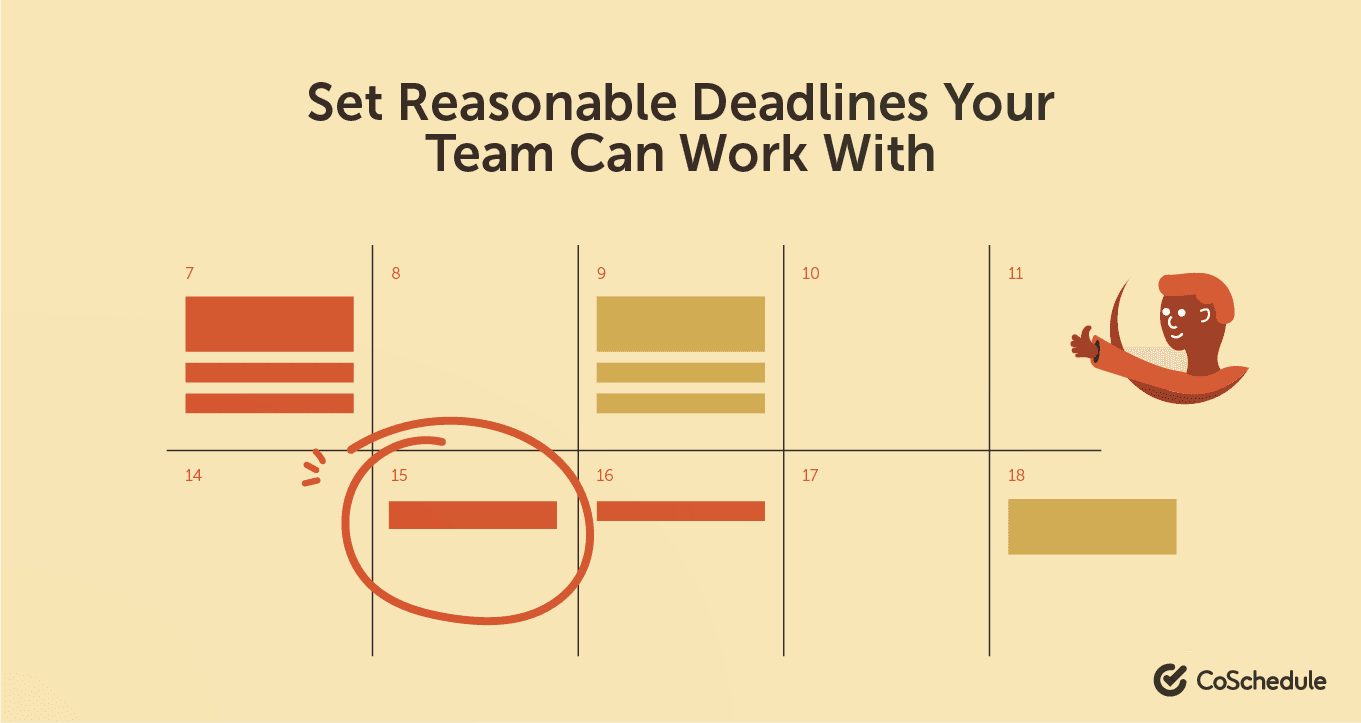 CoSchedule helps teams collaborate together on content marketing projects, like blogging, social media, and events. The tool allows teams to assign different tasks to multiple people working on a given project, while minimizing the use of email.
CoSchedule helps teams collaborate together on content marketing projects, like blogging, social media, and events. The tool allows teams to assign different tasks to multiple people working on a given project, while minimizing the use of email.
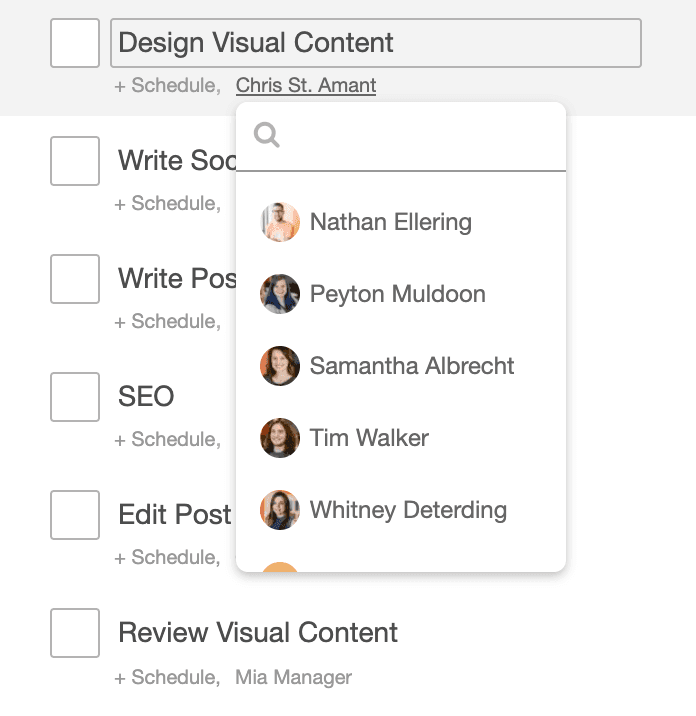 Just remember that you can use CoSchedule to assign tasks and deadlines to your entire team.
Based on roles, you can customize your workflow, set deadlines for each team member's unique tasks, and comment back and forth to the team right in CoSchedule.
Just remember that you can use CoSchedule to assign tasks and deadlines to your entire team.
Based on roles, you can customize your workflow, set deadlines for each team member's unique tasks, and comment back and forth to the team right in CoSchedule.
Smaller Deadlines Within Your Large Deadline
Each week, we put out two blog posts on our CoSchedule blog, among other templates and projects. Using CoSchedule's task templates is a huge lifesaver for us — especially since our team is spread out across a few different locations. We have a set list of what needs to be done each week, and we rely on checklists built using task templates to help everyone working on the project know the steps they need to complete in order to help us publish our content on time. Use these tips to break down your bigger deadlines into smaller ones:- Look at the big picture and draw a road map of exactly what you need to do.
- Separate tasks based on who needs to complete them.
- Create an outline labeling what needs to be done and when.
- Ask yourself what needs to be done in order? What can be done whenever?
- Delegate tasks based on who needs to do what, and then fill the gaps with tasks that can be done whenever.
Build In Buffer Time
Write down all the tasks you need done and when you need them done by. Then, give each of these due dates a day or two of buffer room before they are actually due so you don't set yourself up for failure. This allows time to make needed changes or even finish your work ahead of schedule.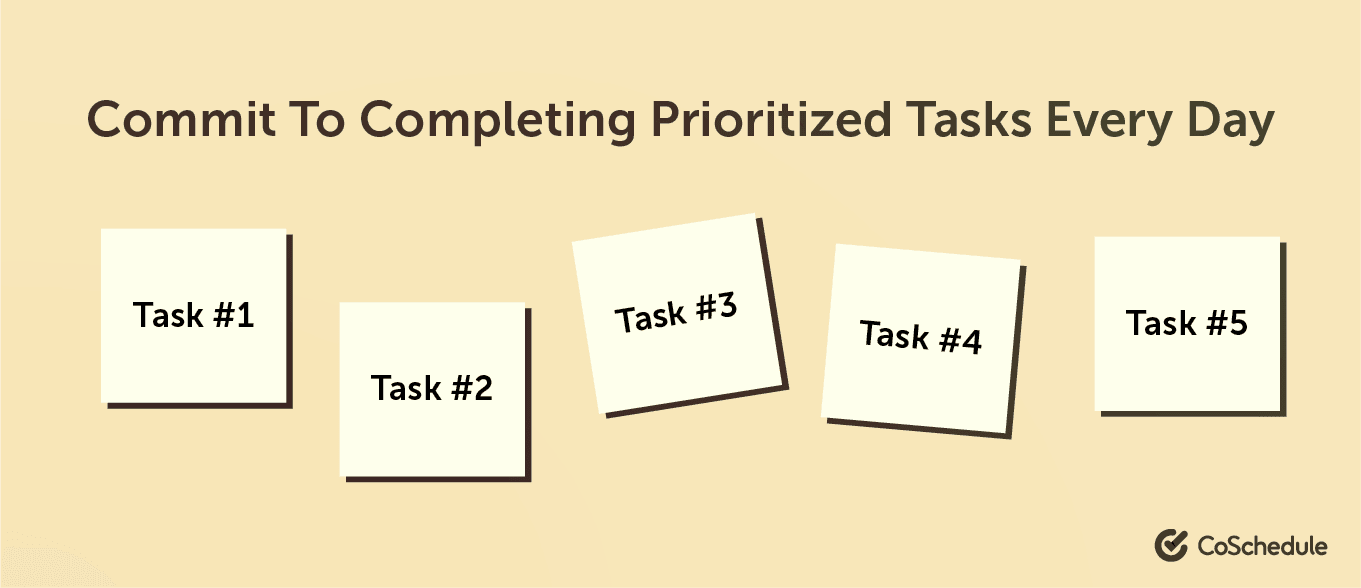 Seth Godin has some great ideas about how to build in buffer time:
Seth Godin has some great ideas about how to build in buffer time:
Write it down instead. Hand it to someone else. Publicize it. Associate it with an external reward or punishment. If you don't make the deadline, your friend gives the $20 you loaned her to a cause you disagree with...Deadlines give you the opportunity to beat the rush. Handing in work just a little bit early is a sure-fire way to tell a positive story and get the attention you seek.
Deadlines give you the opportunity to beat the rush.
Click To TweetBe Mindful of How Much Work You Can Manage
This is one of those pieces of advice where it’s a “do as I say and not as I do”. Many of the people on our team struggle with this daily. We want to help everyone, do more, and be busy, so we will have to work on this one together. Everyone has 24 hours in a day; there are limitations to what can be done and what can be done well. You know your strengths and weaknesses, look at what’s on your plate for the week, and go from there. Make it a point to write a mock schedule of everything you'd like to finish for the week. Do this weekly on Sunday night or Monday morning. Schedule in any meetings you have, appointments or reasons you won't be in the office, and make sure you leave time for sleep (seriously).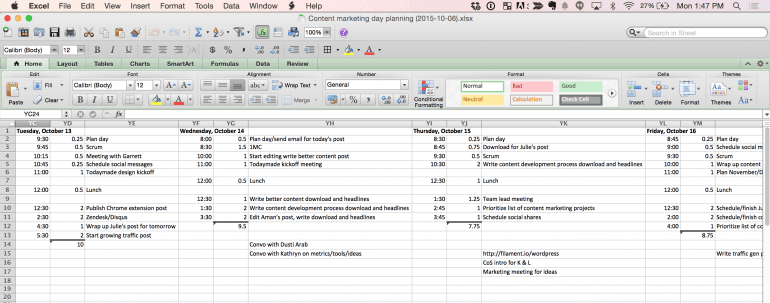 Nathan Ellering, CoSchedule’s Head of Marketing, literally plans out what he'll do every single day to keep himself on task. It helps him learn how much time certain projects really take to help him use his time even more efficiently for future projects.
This will help you know exactly how much free time you have in the day and week, while keeping you accountable for meeting your personal deadlines and helping you improve your time management skills.
This way, when someone comes to you with a new project or idea, you can look at your schedule and realistically know if you can fit one more thing on your plate or not. You’ll save yourself the stress and hassle of overdoing it.
Here's how to do it yourself:
Nathan Ellering, CoSchedule’s Head of Marketing, literally plans out what he'll do every single day to keep himself on task. It helps him learn how much time certain projects really take to help him use his time even more efficiently for future projects.
This will help you know exactly how much free time you have in the day and week, while keeping you accountable for meeting your personal deadlines and helping you improve your time management skills.
This way, when someone comes to you with a new project or idea, you can look at your schedule and realistically know if you can fit one more thing on your plate or not. You’ll save yourself the stress and hassle of overdoing it.
Here's how to do it yourself:
- Value all your time: Know that you have 24 hours every day, just like everyone else (even Beyoncè). Hopping onto Facebook, texting, or a mindless zone-out adds up. The average Facebook user spends 17 minutes on Facebook a day. That’s four and a half days a year. Imagine how much you could get done in that extra time.
- Focus on your work: While zoning out can distract from work, it’s a proven fact that daydreaming can actually put off the desire for future rewards — because you envisioned success but did nothing to achieve it. Being actionable helps you achieve your goals; big game talk and daydreaming don't.
- End procrastination:
- Start easy
- Break it down
- Be nice to yourself
- Get a good “why”
- Be mindful
When in Doubt, Ask for Clarification
Your company expects you to be a self-starter and to take on new projects. These are great qualities to have, but that doesn’t mean you can’t ask for clarification on your projects before you get started. It'll save you time.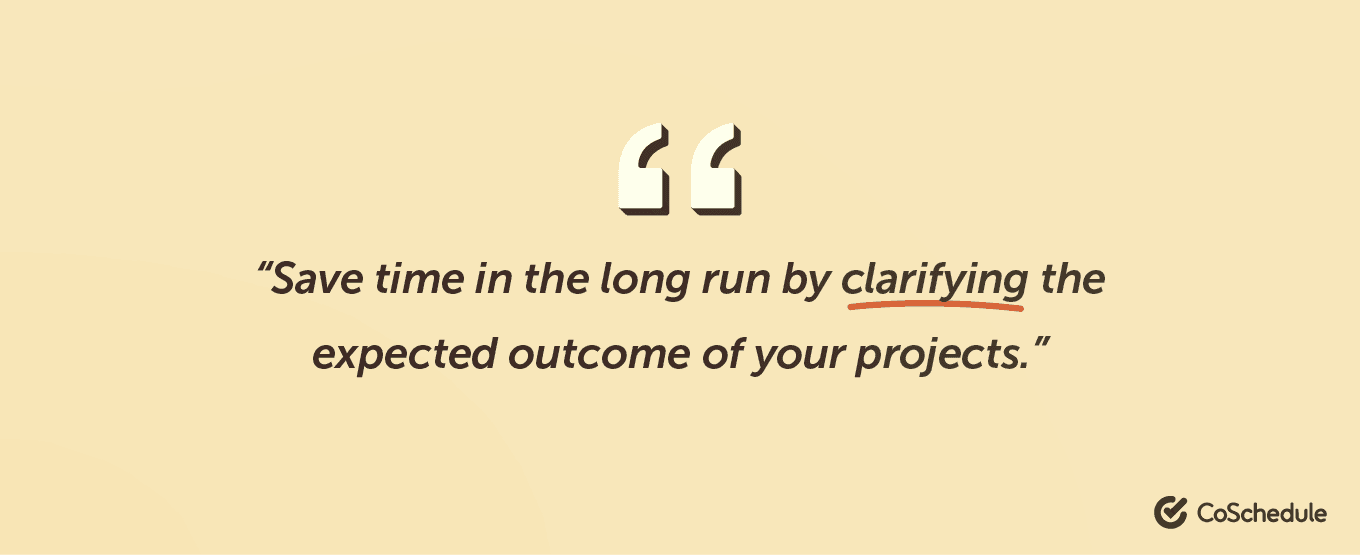
- Admit you're unsure and get the clarification you need.
- Ask open questions — this makes it easier to get more information from people than simple "yes" or "no" answers. They are more likely to give you more detail of exactly what you are looking for if you ask open, follow-up questions.
- Ask for specific examples of outcomes to envision what your project will look like.
- Know the goal of the project. Focus on your audience's needs instead of just producing content because you can. Just because it's some of your best work doesn't mean it was what was being asked of you. Make sure to stay on task.
- Repeat what your team lead just told you to make sure you understand what they really mean.
Use a Content Calendar to Visualize Deadlines
One of the easiest ways to stay focused on your project goals and deadlines is to use a great content calendar. An effective content calendar is the perfect way to showcase the projects you and your team are working on, deadlines for each project, what’s coming up next, etc. This is where CoSchedule’s Marketing Calendar comes in handy. With team calendars, task templates, social media integration, data analytics, and so much more — all in one place — CoSchedule is the next best thing since sliced bread for all teams!
With team calendars, task templates, social media integration, data analytics, and so much more — all in one place — CoSchedule is the next best thing since sliced bread for all teams!
There’s Always Room for Improvement
Resist the urge to work on easier projects. Motivate yourself — maybe a mirror pep talk — and work toward your big-picture goals, at least a little, bit every day. In the long run, you'll be so much happier when your plate becomes full again, and you're already ahead of the 8 ball.Motivate Yourself Every Day
Make time for yourself. The more “you time” you get, the more refreshed and prepared you'll be to get your work done and meet your deadlines. When you decide to take on a task each day, set aside 25 minutes to work on just that. Turn off as many distractions as you can, then you can go back to “you time”. This is what some call the Pomodoro technique — a time-saving process to help you focus on accomplishing your work. If you’re starting to feel unmotivated, one of the best ways to get your energy back is to get on with your work. Make a checklist of what needs to be done for the day. In Evernote, you can make an easy checklist with just a push of a button.
Using Evernote to keep checklists is easy because they are accessible, 24/7, from your phone, laptop, or iPad. Here's how to make the most of this feature:
In Evernote, you can make an easy checklist with just a push of a button.
Using Evernote to keep checklists is easy because they are accessible, 24/7, from your phone, laptop, or iPad. Here's how to make the most of this feature:
- Prioritize all of your ideas in an Evernote document.
- Make a list of tasks you need to complete today, tomorrow, and for the week.
- When you don't get a task done, make sure to put it at the top of the list for the next day.
- Attack the hardest tasks first. While it may seem easier to do the little things first, it would be too easy to keep pushing the big tasks off. This also defeats the purpose of trying to hit your deadline.
You are not a tree; you are not stuck. You can pick yourself up and try again.
Click To Tweet

